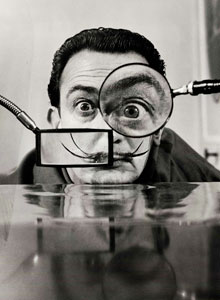I believe it must have been the late winter or spring of 1962. I had been reading about the ‘mad’ Salvador Dali in various magazines like Life. At that stage I did not yet properly know what Surrealism was (the concept was still vague in my mind), and my image of Dali was that of a highly talented artist who staged what were then called happenings. This appealed to me, because they seemed to represent a form of anarchy akin to that of my favourite comedians, the Marx Brothers. Dali appeared to represent a kind of highbrow’s Marx Brother, someone whom Margaret Dumont might find slightly more socially acceptable because his dinner jacket would not be falling off and his shirt-tail would be tucked in. (His moustaches, of course, would be even more outrageous than those of Groucho, but I was a great believer then in having one’s shirt-tail tucked in.) At that stage of my life, having just turned 17, I definitely thought that only the arts mattered. I had not yet accepted the necessity for business and industry, and was only grudgingly beginning to admit that science had a place. It is amazing how snobbish and narrow-minded teenagers can be, even ourselves.
I had already seen the amazing film Un Chien Andalou, written by Dali and directed by his friend Luis Bunuel. I knew a fair amount about Bunuel because Bonnie Liebermann (later Barbara Brenner) who was in my geology class and a great pal of mine had had an affair with his son the previous summer and told me all about the Bunuels, and I had seen as many Bunuel films as I could manage, though the other one he did with Dali, l’Age d’Or, had been impossible to see so far, as it was so rare and had been banned by the Catholics, who always spoil everything.
I began to brood about the happenings of Dali, which were all the rage. He was being paid fabulous sums of money by spoilt rich people to stage happenings. I began to worry that I had no access to such an event, and that I was missing a major cultural phenomenon. What was I to do? As a friendless and penniless kid, two years younger than all my contemporaries at university, barely able to scrape together enough money to pay for a coca-cola, much less the bus fare from Philadelphia to New York, and without even an overcoat, not to mention anything suitable to wear to a happening (my mother had given me $15 to last me for one year at university, and my shirts all had short sleeves), how was I going to find out more about these things? I was of course perfectly prepared to crash a happening, as I would later crash Manhattan parties in penthouses (having secured a permanent place to stay at Mia Agee’s house, thus solving my problem of being unable to afford a hotel), but first I had to get to New York and have somewhere to spend the night, find out where the happening was in advance, shave (always difficult in a bus station), find the 15 cents as I believe it then was for the subway, and try not to freeze on the way there because I had nothing to keep me warm. Yes, the problems were multiplying the more I began to think about them.
The first happening is often said to have been staged by Stan Kaprow in the USA in October, 1959. However, that is merely the first use of the word ‘happening’ to describe an unusual event in the English language in America. ‘Happenings’ under different names had been going on since 1917 at least, amongst the Dadaists in Zurich and Paris, and passionately continued by the Surrealists in Paris, one of whom was none other than Salvador Dali himself. As late as 12 May 1958, Dali participated in what is now called a happening at the Theatre d’Étoile in Paris, when he turned up with a fifteen-metre loaf of bread under his arm. This was pure Dada and pure Surrealism, and a perfect example of a happening. As Dali said when he was older: ‘The only difference between me and the Surrealists is that I am a Surrealist.’ There is a lot to that. After all, Louis Aragon and Paul Eluard, amongst the founding fathers of Dada and Surrealism, both ended up serving the false god and grim doctrines of Stalinism, and lost the plot altogether. But Dali remained true to the spirit of anarchic fun, or what he preferred to call psychopathic paranoia, in the midst of his own fantastic personality cult. Certainly there was no room for Stalin in the Personality Cult of Dali, as even Dali himself was too big to squeeze into it properly, considering that more than fifty percent of it was already full just accommodating his adored Gala, the bisexual Eluard’s previous wife whom he had stolen, and at whose feet Dali ecstatically grovelled even more submissively than Aragon did for most of his adult life at the feet of his wife Elsa Triolet.
But all of this was still unknown to me. I was operating on instinct. How was I going to gain access to a happening in order to explore this exciting new phenomenon? I didn’t know anyone, I had no money, few clothes, and no way to get there. Having plenty of nerve was not enough, as I was in the wrong city. I began to wrack my brains and finally settled on something which was not so much a compromise as something even better still. I had to accept that participating in the actual spectacle of a happening and seeing one for myself was just not going to work. So I would up the ante. I would go one better: I would meet Dali, who as the source of the happenings was bound to be more interesting even than a happening itself. After all, what would you choose: to meet Shakespeare or just to see Hamlet?
So I discovered where he was lurking. He was at that time living in the St. Regis Hotel on East 55th Street, just off Fifth Avenue. He always stayed there when he visited New York from Spain. I already knew the hotel, as I had explored the area thoroughly in my many prowls. (I am an inveterate prowler of cities, compulsively exploring every nook and cranny by foot in all weathers, especially at night when the effects are more atmospheric.) After all, I had a bizarre friendship with Victor Hammer, the brother of Armand, whose art gallery was nearby, and he and I had already shared a cream soda and bagel at his favourite deli in that neighbourhood (he generously paid). Also, I believe I had already gone wading in the Plaza Fountain by that time, at 59th and Fifth, and been taken to the Oak Bar of the Plaza, where my friends and I gawked at the amazingly beautiful Lauren Bacall and Natalie Wood, escorted by their respective husbands, Jason Robards, Junior, and Robert Wagner, all four sitting snug as anything together as close pals having a dinner out together, directly opposite us. But those evenings are another story. (Obviously, I wasn’t paying, as I could never pay for anything. See the photo of me in the Plaza Fountain on my website.)
Having pinned Dali down to a location, all I had to do was to accost him in his lair and find some thing to fascinate the beast’s gaze long enough to hold him fast while I examined him carefully. And oh yes, I had to find some way to raise the bus fare.
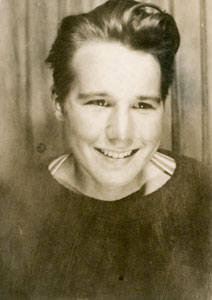
So I told my pal John Osborne about this plan. That’s why I know it had to be the late winter or spring of 1962, because John dropped out of Penn after that spring, having completed only one year of his studies. (There is just a chance that these events happened on a later visit to Philadelphia by John, when he came to see me in a subsequent year for a few days, in the spring of 1963.)
I said to John that we were going to go to New York together to meet Salvador Dali. John gave his usual delighted giggle, thinking it a splendid joke, and what a wonderful thing to imagine. Of course John knew who Dali was. Everybody did. Even people in the furthest boondocks knew who Dali was, since they used Life Magazine, if only to wipe their bottoms in their outdoor privies, and would have seen him grinning at them with his moustachioes before they made themselves clean. John did not believe me. I said no, I wasn’t just making it up, we really were going to meet Dali. But he had to pay the bus fare for both of us, because I had no money. John always had some money because his father was an editor of the New Republic and was fairly rich. (I later befriended his fascinating father, also called John Osborne, in Washington, but that was long in the future and another strange tale, in fact, one that borders on the incredible.)
When John realized I was serious, he assumed I had made an appointment. I said no, there was no appointment, but I knew where he lived, and my plan was to take him by surprise in the morning, because he was a late sleeper, and he would not be out socializing and having his photo taken yet. This sounded plausible. I said I knew a really cheap hotel where we could spend the night before, the Lancaster on Madison Avenue in the thirties, alas no longer available for penniless waifs as it then was, having long since become something else that costs real money. John and I went over to his favourite restaurant at Father Divine’s Heaven and ate soul food amidst all the religious black mammas, where I tried unsuccessfully once again to lecture him on how disgusting grits were, but he had a divinely tolerant smile, and just grinned at me as he ate his collard greens and roast chicken with gravy, followed by genuine home-made lemon meringue pie instead of the store-bought stuff. John was mildly curious as to whether we might really pull this adventure off, and in fact was certain we would not, but what he really wondered about was would they let us in the door of the hotel, because we were just a couple of kids, but anyway it would be a great adventure. And if there was anything John truly loved, it was mad adventures. (After all, had we not become eternal brothers because we had both eaten magnolias together on a dangerous building site after midnight, having failed to peek into the girls’ dorms with any success, and shouting quotations from poetry and lines from Lorca’s plays? We were game for anything.)
There was just one more thing: could we take Bunny Gilbert? The answer was no. She didn’t have any money either, and we couldn‘t bear the cost, as he was already having to pay for me. And anyway, three might be a crowd, as we were after all trying to examine Salavador Dali up close, and three kids surrounding him might be one too many and make him nervous.
So we fixed on a day very soon. John absolutely loved ‘slumming it’. He hated accepting money from his parents and felt bad taking the more expensive train to New York. He was thrilled when I suggested we do something really adventurous, namely take the Trailways Bus, which was cheaper even than Greyhound. John loved black people, and the idea that there would be lots of black people on board excited him. He always thought that if he just got friendly with lots of black people it would be a kind of shortcut to real life, and he could escape the suffocating social snobbery of his mother and all her senator and congressman friends, and those horrible boring socialites.
John was such a splendid fellow, with a heart pure as gold, a true innocent-at-large. He was a dreamer, an introvert, a lover of poetry, an idolizer of ‘perfect girls’, and really more of a 1920s young man than a 1960s one. We spent a great deal of our time excitedly discussing poetry and literature. It was a pure 1920s friendship, and we were definitely living in the wrong time. The Beatles had not come along yet, so we couldn’t hate them yet as we would later, but we both agreed that we adored Roy Orbison and Buddy Holly, as we were great lovers of ballads. And we spent many evenings at The Gilded Cage listening to the bewitching Israeli girl sing her folk songs, as I have described elsewhere. John agreed with me that the one about ‘the wild goose grasses agrowin’ over me’ was a stunner. Also, we thought she was much better than Joan Baez. In those days, Joan Baez had a monotonous high whining voice which irritated us immensely, and it was only when she became older and her voice deepened that Joan Baez became irresistible.
The story of how someone later impersonated John, and kept a file on his characteristics in order to study how to take on another person’s identity as the basis for writing a novel about becoming someone else is so bizarre that it has to form a separate story. One reason it is like something out of a novel is that it was intended to become one! And the man involved had already written a best-seller which was made into a Hollywood movie and a TV series as well. But he never dared to write that one, because I ‘found him out’, and he may have been afraid of being sued. However, to go into that now really would lead us astray, and it took place many years later. I did get to know the naughty novelist, who was a very amusing fellow. I secretly regret that he never wrote the book.
So we set forth, John gleefully buying the bus tickets, which were dirt cheap, after all, to anyone but me. Trailways seemed to be unknown to all the other students. It had a pokey little depot down on 12th Street where drunks were always asleep on the benches. Greyhound, which was much more expensive, had a clean and shiny depot, and was used a lot by students who thought they were being economical by saving the cost of the train. (Rich kids of course just took the train without thinking about it, and could not imagine any kid doing anything else. Those kids who economised by taking Greyhound kept quiet about it, not wanting anybody to know they weren’t rich, since in America the only thing that counts is money, and if you let anyone know you haven’t got enough, or worse still haven’t got any, they all drop you and you are finished. You can never get a job and never have a friend again. It is worse than having leprosy, and poverty is genuinely thought to be contagious in America.)
Off we went, John giggling in his charmingly childish manner at some of the strange people on the bus with us. He absolutely adored the bus ride, and being amongst people who were so ‘real’ it made my blood run cold. I never shared John’s wholly romantic view of down-and-outs. On any Trailways run to New York you could always be sure of some thieves and prostitutes, and three or four obese mammas with crinkling paper shopping bags bigger than they were who dramatically tried to squeeze them into places where they couldn’t fit, so that they ended up taking up a whole seat beside some hapless person who was shamed in front of the whole bus into saying he didn’t mind. Then the large mamma would sit down into her seat which barely held her, issue forth an enormous sigh which filled the bus like a long wisp of cigar smoke, and then generally mutter to herself something like: ‘Oh Lordie’, or ‘I don’t rightly know’, or ‘Didn’t think I’d make it’, still being greatly out of breath from rushing for the bus. In those days there were no horrible mobile phones, and transistor radios didn’t properly exist yet either, though some of the swingers on board would nevertheless produce battery radios and listen to something for a while until the poor reception exhausted even them, and they switched them off, having briefly and ineffectually made the point that they were someone cool.
John’s eyes were all-agoggle at this taste of reality. But as everyone settled back into a somnolent state once we were on the New Jersey Turnpike and the bus loudly droned its way to the distant metropolis through the enormous nothingness of the journey, John began to talk excitedly about intellectual and artistic matters, and then we both drifted off into a half-sleep, inoculated by the ennui of travel which falls upon the eyelids of those who suffer journeys for the sole reason that they want to arrive somewhere, and when the journeying has no charm of its own.
I received a lot of strange looks when boarding the bus because I insisted on carrying with me the expensive and glamourous leather suitcase, which I kept securely on my lap. That suitcase certainly cost more than the fares of several of the passengers both ways, and many of them knew it. I got some gazes of appraisal from some of the young black men with shiny watches which they flashed, and I could see the computations going on in their heads about what they could get for it. All the more reason to be travelling with a friend. If I had been on my own, it might well have been snatched, but two of us were too much to make a tangle at the other end worthwhile. Inside that case was my secret weapon: the means to render the beast mesmerised while I examined him; inside was my Dali-dart.
We drew wearily into Port Authority Bus Terminal, the bus wheezing to a halt and the pneumatic door opening while the driver cheerily informed us that we had arrived, and he then leapt out to open the side baggage hatch. We all rustled upwards and shuffled outwards, there being a great crush, and no one was polite. John cowered in his seat at sight of all the protruding elbows, not wanting to enter the fray, so we were among the last to leave.
From the bus terminal on 8th Avenue, we decided to walk across town to Madison, which was a lot of fun because we went down to 42nd Street and crossed there. This meant we could walk past the long line of cinemas and laugh at all the outrageous porn posters. John found it hard to believe when I told him that only 13 years before, this had been a decent street, and that all those run-down cinemas with porn films had then been showing main-stream films and ordinary decent people were queuing up to get into them day and night. I explained that this street had then been my idea of Heaven, as since the age of three I have been a film fan. As a small child, on my most fortunate days, this was the street I most wanted to visit and browbeat my mother (who rarely required any encouragement to go to a movie) into taking me to see those wonderful black and white movies with men in hats and trench coats and glamour gals luring them on, and hopefully having a gun and getting the men into trouble. I only got bored when there were the regular routine intervals of what I yawningly called ‘love stuff’, when the men and women wasted a lot of screen time kissing and looking longingly at each other, which for a kid who wants action on the screen is a horrible distraction. Even the best action films seemed to be ruined by ‘love stuff’, which grownups seemed to require for reasons entirely beyond my comprehension. John and I had a good laugh about ‘love stuff’, which seemed to have taken over altogether now, in its most lurid form.
When we reached the dismal and grim Lancaster Hotel on Madison Avenue at the southeast corner of 38th Street, which was my little secret for a cheap stay in Manhattan close enough to walk to the things that count, John was absolutely thrilled. Here was a real cheap Manhattan hotel of the kind he had seen in the movies or perhaps imagined, and nowhere that his mother would ever stay. (She would doubtless consider herself engulfed in filth and germs by going any further downmarket than the Waldorf.) John could not believe how cheap it was. He gleefully agreed to the price of two rooms, which were about the size of a broom closet, with shared bathrooms for everyone down the hall. He thought this was ‘really living’.
I can no longer remember where we ate, perhaps because it was unmemorable. There are, after all, some things that drop away.
In the morning, John and I passed each other in the corridor, he with his towel on his arm smiling beatifically. He had just performed the unnecessary process of shaving, as he had almost no beard. We had made an early start, as we had serious business uptown. We went to one of the many local breakfast places with stools and a counter and a wisecracking waitress and had absolutely wonderful fried eggs and bacon. Nowadays, the quality of such places has declined, but then an egg was still an egg and had not yet become a blob of nothingness. Also, the bacon still tasted good, and had not yet become a strip of solidified hormones and antibiotics with some artificial ‘dead pig flavouring’ thrown in. (From which you may gather that I only eat organic meat since I really ‘grew up’, and that I am hostile to Conagra and McDonalds.)
I always feel nervous approaching the St. Regis from Madison Avenue, and feel that I must go round and approach it from 5th Avenue instead. I can’t say why, and now that the St. Regis has gone downhill and the Plaza is boarded up, why should such a thing matter? But then as always I wanted to come at the St. Regis in the right way, so as we walked up Madison from 38th to 54th, I turned left to 5th a block early. John was smiling energetically, but I could see he was a bit nervous, because this was getting a bit too real for him. It was great to think about crashing in on Salvador Dali, but it was obvious that I was not just a talker. However, he felt more or less confident that I would not allow anything too awful to happen. All he could do now was trust me.
I had of course familiarised myself with the St. Regis lobby situation on a previous occasion (it is now entirely changed). The first thing you have to do is look like you know where you are going, and we entered and went straight across to the house phone, ignoring various attentive staff who are always a potential danger when you are trying to crash in on Salvador Dali. John smiled apologetically at them as I hurried him past. He was wearing a very fine expensive overcoat given to him by his mother, so he looked as if he might really be staying there, and in fact, John’s relaxed manner always suggested harmless affluence and someone who would not cause any trouble. I had a great deal of difficulty persuading the switchboard to put me through to Mr. Dali, insisting that he was expecting my call. I think the only reason I succeeded was that the staff all knew that Dali was such a weirdo, that people like me might really show up, and probably sometimes did. I knew Dali was too alert and curious to take refuge behind the unimaginative man’s protective barrage of ‘no calls please’. Dali would never want to miss anything, even me. After all, part of being a paranoid genius is that you are always waiting for the call.
He picked up his own phone sleepily, as he was obviously still in bed or perhaps having his coffee already in his silk dressing gown. I explained my business and, knowing he would not want to see me at that hour, arranged to see him for a drink in the evening in the tiny lobby at a little table, of which they then had a few, though now that area has been swept away by some new broom.
John was breathless. What? Dali would see us? Was I sure? I said to John I hoped he had enough money to pay for some drinks at the St. Regis, because we would have to offer, even though I hoped Dali would munificently put them on his bill. John had heard my end of the conversation but wondered if I were spoofing him, and that Dali had not really answered. I said we might need as much as twenty dollars for the drinks, as Dali was a high liver and would want champagne, and John assured me he was good for it.
We went across to the zoo and looked at the seals and sat down on a bench, even though it was cold. John looked at me flummoxed and said: ‘I can’t believe you’ve really done it. How did you persuade him to see us?’
Although he had heard what I had said to Dali on the phone about them, I had not yet shown him all of the photos in the leather case, which I opened, and he looked through them one by one in mounting astonishment.
I said to John that Dali was in love with weird things, and there was no way he would want to miss these. John agreed. As he looked at the photos, his eyes got bigger and bigger and he giggled more and more hysterically.
I had borrowed the expensive case and its contents from Arthur Young, as part of my plan. Arthur was yet another of the many millionaires I have always known for some reason, none of whom ever noticed that I didn’t have an overcoat or even thought of such things. I have always acted with millionaires and billionaires as if there is no difference between us whatever, and they have generally taken me at my word and thought no more about it. I have of course never asked a millionaire or a billionaire for money, even a loan, as that would be too appalling. I have very strict views that people own what they have, and it is their business, not mine. In fact, I am so fiercely independent that I never once asked anyone for a meal or even for a sandwich when I was literally starving, as I looked upon my starving as my business, not theirs. At the time we went to see Dali, I was surviving on one meal every two days, though I never told anyone, of course, as it was my private affair. However, I had very much enjoyed the eggs and bacon, and before that the chicken and collard greens, which had been offered, not requested, so that was all right.
The photos continued to astound John, who pummelled me with questions about the objects in them. He became highly excited, and when that happened, he always blushed deeply in his cheeks and his eyes shone. So I told him what they were.
Down in Mexico, at an obscure place called Acambaro, an eccentric old codger named Julsrud had settled in a large house. He was a German, one didn’t want to enquire quite what kind of a German, and he was cantankerous, or even dead, I no longer remember which at that time. (I say this on the premise that one cannot be cantankerous and dead at the same time, though there is no certainty of that, and I am inclined to be sceptical.)
I stressed the correct pronunciation of Julsrud, as I always hate it when people mispronounce German, especially names. It should be pronounced yulesrudd, I told John, and his first name was Waldemar, but that didn’t matter. He had taken an interest in the antiquities of the area, and begun to finance private digs. He had unexpectedly discovered a gigantic cache of weird terra cotta statues, so utterly bizarre that no one could believe them to be real, and it was claimed that they were fakes. But Arthur and Ruth had visited Julsrud with their friend Leonora Carrington the crazy painter whose works they had on their walls (I did not at that time fully appreciate that she was a Surrealist and probably knew Dali), and all of them were convinced that these weird statuettes were genuine. They thought, as did Julsrud, that they represented some incredibly ancient culture from the days before Atlantis or Lemuria sank. (I had to explain to John that those were two lost continents, one in the Atlantic, and the other an earlier one in the Pacific, whom such people believed in.) John was getting so thrilled with all this that his adventure was far surpassing his greatest hopes even if he didn’t get to meet Dali. John asked me how many of these things were there, and I said over 40,000, at which he nearly fell off the bench.
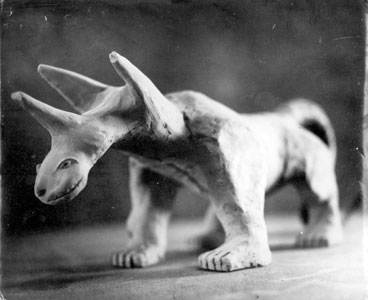
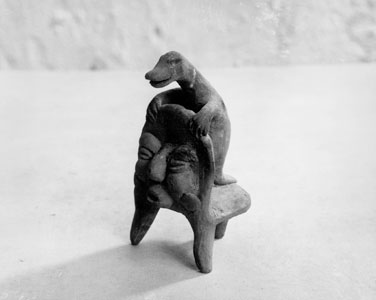
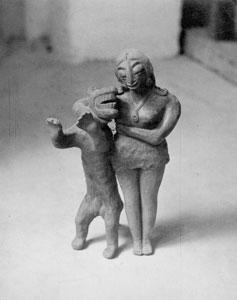
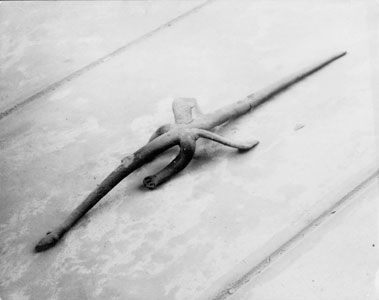
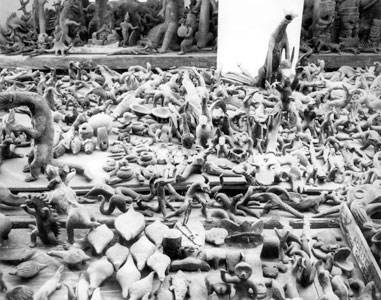
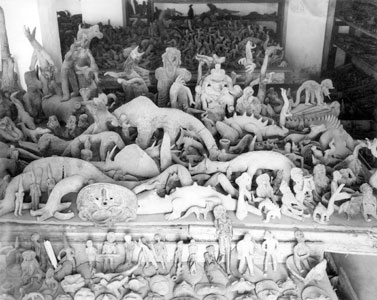
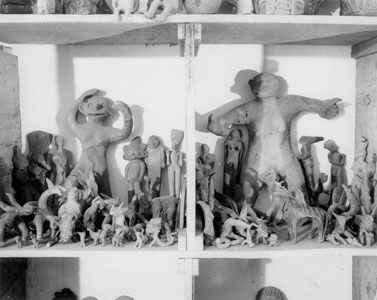
Some original photos of the Acambaro Figurines of Mexico, showing the
fantasy dinosaur-like shapes, with touches of macabre humour.
I still have a charming little Acambaro figurine, and a fragment of another, and a few photos. But of course the case full of magnificent 8x10 prints taken by a professional photographer at Arthur’s expense were returned to him. A few stray ones which got left out somehow I unexpectedly discovered that I still have, and some are reproduced here.
There was one problem with the Acambaro figurines: they showed dinosaurs.
Well, if you don’t believe me, go to the Julsrud Museum as it is now called in Acambaro, Mexico, and see for yourself. It is in the state of Guanajuto. Or try googling it. You can see some photos of the dinosaur figurines on the web. They were partially unpacked from their crates and displayed only in 1999, and are now realised to have tourist potential.
I still have my copy of Mystery in Acambaro (1973),the illustrated booklet written many years later about the figurines by Charles H. Hapgood, whom I knew through Arthur. The figurines had originally been discovered in the early 1940s, and reported initially in a publication in Spanish, Enigmas del pasado, written by Julsrud himself, in 1947. Hapgood excavated a lot of the figurines personally, and found some under the floor of the house of the police chief of Acambaro, whose house had been built 25 years before Julsrud immigrated to Mexico, thus disproving the hypothesis that Julsrud had faked them. In fact, one of the things that made Arthur Young upset was that thermoluminescence tests showed that the figurines were genuinely old, but no one would accept them anyway, because they showed dinosaurs. Professor Fro Rainey (who later married my cousin Marina) took them seriously enough to have them studied and analysed a lot at the University Museum, of which he was the Director, before concluding that he could not accept them, although he never closed the door on them entirely, as he told me ruefully. But as he said in his good-natured way: ‘What can you do with a lot of figurines of dinosaurs? Claim they are contemporary?’
In other words, how can anybody accept statuettes showing dinosaurs, which became extinct before we existed as a species? And so that is the problem, you see. My theory is that these figurines, which seem to be significantly old, may have been made by a cult of people who got high on peyote and had these visions which they moulded in clay. Who knows?! In 1976, a report was published in the journal American Antiquity disputing the drastically early thermoluminescence dates for the figurines which had been pubished earlier (which had shown potential ages of between 4480 BC and 1060 BC), and suggesting that by a complicated technical reinterpretation of the results, taking into account the presumed firing temperature, etc., the figurines could all be reinterpreted as having been fired in 1939 AD. Well, that is one way to kill a controversy! No archaeologist is ever going to look at something again after another archaeologist claims to have proved it a fake. Personally, I hold no view. I think they ought to start all over again and do some new thermoluminescence tests, using improved technology, and try and get some kind of unanimity this time.
However, all this scientific work was still in the future. In 1962 this was all a great mystery, and just the sort of thing for Dali. After all, these statuettes were indubitably examples of paranoid genius of the kind which he believed that he exemplified more than anyone or anything else in the Universe. I had told him on the phone that even he would be amazed. And that clinched it.
The time came for us to return to the St. Regis. John was getting really nervous. The imminent reality of Salvador Dali actually appearing before our eyes was spooking him. John was inclined to fantasies and reveries, not to things that actually happened. We entered the St. Regis, with its tiny lobby area, and I asked politely at the desk whether they would ring Mr. Dali and inform him that I had arrived. I got a strange look, but the fellow did as I requested, and seemed to start when he evidently heard Dali say that he was coming down. We were invited to take a seat ‘over there’, and sat at a small table where drinks could be had, and waited a considerable time before Dali actually did appear.
As soon as we saw Dali, we knew it was all worth it. He was immaculately turned out with a kind of dark blazer jacket and bow tie, and I believe striped trousers, he carried a splendid dandy’s cane, and of course there were his incredible moustaschioes, sticking straight upwards at the ends and pointing at the ceiling. He was dressed as if to receive a royal personage. I can only imagine he did this every evening. He couldn’t possibly have dressed for us, as he didn’t know us, and in any case I hadn’t mentioned John, so that he was not expecting to be bushwhacked by a second youngster as well.
He came walking towards us very formally, almost mincingly, looking unsure as to whether the two scruffy kids might possibly be anything to do with him. (Well, John was not particularly scruffy, but I suppose I must have been.) I leapt up and introduced myself, and he seated himself tentatively beside us with very good grace, in the manner of a practiced aristocrat who could endure the company of any local riffraff when required to do so by duty. He could not conceal his curiosity, however. I hastened to introduce him to my friend, of whom he took little notice, while he regarded me with concentrated scrutiny. It was now he who was examining me, rather than I who was examining him. He also saw that I had a wonderful brown leather case, which was precisely the kind of detail to thrill him in an unexpected encounter. The way in which his eyes returned to me after considering the case was wonderfully ambiguous, and he waited for me to speak, having decided upon silence as the kindest of attitudes under the circumstances.
‘It is so kind of you to see us, Mr. Dali,’ I began, or something to that effect. ‘I realize you do not know us, and you must be besieged by people who want to make your acquaintance.’
He nodded in agreement and kept his own counsel.
‘I really felt I could not keep these things from you. Of anyone in America, or in America and Europe frankly, who could and would appreciate seeing them, who could be better than you?’
The suggestion of a superlative in relation to himself was warming him, but he also showed alarm:
‘You wish to sell me something? I am not buying. I never buy things.’
‘Oh no, I would never do a thing of that kind. I certainly never would approach anyone with an intention to sell them anything.’
He looked relieved, but now more than ever puzzled: ‘You never sell things? Why are you here, then? People are trying to sell me things all the time.’
‘Mr. Dali,’ I protested with vehemence, ‘I would never attempt to sell anybody anything.’
The horror with which I spoke this earnest sentiment convinced him. He could see that I had some other business, and relaxed a bit in his chair.
‘Well then, we must have something to drink. What would you like?’
A mere flicker of a look over his shoulder, and an attentive minion was there like a flash. They had been watching, their hearts in their mouths. A collective sigh emanated from the staff.
I was far too interested in Dali to remember what we ordered, and the process of selecting something and consuming it was lost in a haze as I stared at this rare specimen in increasing amazement. Finally, having dispensed with the ordering, Dali waved the man off with a grand and practised casual gesture of the wrist, as if he were a duke or a prince from olden days.
Dali laid the ground for his escape from us by cautioning us that he was expected for dinner, but meanwhile we could have our little drink and I could tell him what I wanted. It was now clearer why he was dressed to the nines. He must have been going somewhere important, but then, did he ever go anywhere that was not? I could see amazing cufflinks glittering, and other things such as rings, a watch, and in fact, finery seemed to be everywhere, but I could not focus on any of it, because all I could take in properly was his face.
Dali’s face was, first of all, exactly as it appears in photographs. That is the first thing to say about it. He had not been enhanced by camera lenses, he had been accurately rendered. But there was far more to his face than any camera could hope to see. First of all, my eyes were captivated by the tips of the moustachioes. He saw me looking closely at them, and was delighted, and seemed to me to sit back slightly and allow himself to be studied. I could see that he really did wax and twist them. I longed to see them unwaxed and untwisted, but I knew there were limits to possibilities, and that was one of them. Dali delighted above all in being looked at. The idea of a young man feasting his eyes on the peculiar spectacle which he presented was exactly the kick he needed in the evening before going out to a grand dinner with dignitaries. I knew that it would be far too personal for me to raise the subject of his moustachioes in any overt manner, and so there was a kind of conspiracy of silence between us: he would allow me to study them, and sit still as for a photographer, and I would say nothing.
The other thing that struck me about Dali was that he was so brown. Not only had he had a great deal of sun, but he was positively Spanish. This took me by surprise, because one expects living icons to be more international than that, and not to bear the badge of origin so obviously upon their physiognomies.
I rushed to become ethnic, and blurted out something about loving Lorca, and having played the Bridegroom recently in Blood Wedding at my university. Dali’s eyes flashed, having spotted an unexpected spark in the young man before him. He proceeded to tell me what a fine playwright Lorca was, what a tribute to Spain, what a gift to the world. I had certainly hit upon a good theme. He was warming up.
I then said that I had received a very kind letter from Ernest Hemingway only a few months before his suicide, thinking to establish another link between us, to create some additional camaraderie. Dali looked doubtful. He thought I must be the most terrible liar, and perhaps he had misjudged me. I hastened to clarify that I was only editing my school magazine, and wrote to him in that capacity, and that he had written a remarkably kind letter to me from the Mayo Clinic, and wasn’t that nice of him! Dali relaxed. He could see that this was true. So I was the kind of young man who wrote to Hemingway and then approached the Great Dali. I must have promise. He became very friendly. As to Hemingway, he showed little interest in him per se, indeed treated the mention of him in an offhand manner indicating that he thought of him as deeply inferior to himself in importance, but the fact that I had that kind of flair made me acceptable.
Now he was receptive: ‘So what do you want to show me?’
I brought the case up onto the table and snapped its gilt fasteners open. Dali appreciated gilt fasteners very much, that was obvious. I had the impression that if it had been up to Dali, all fasteners would have been ordained by God to be gilt.
I had already arranged the photos inside so that the weirdest were on top, as I realized that he would not look through them all and he had to see the really remarkable ones immediately, or his interest would be lost. I said nothing, but handed the first photos to him silently. He accepted them tentatively, as if he did not like to be handed things. I suspected that he must have neuroses about being touched and about alien objects coming into contact with him. The expression on his face when he saw the first photos was really priceless. For Dali to be astonished was no small thing!
‘What do you think?’ I asked quietly.
‘But what is this? What are these strange things? I have never seen anything of this kind before!’
‘That is exactly why I brought them to you, Mr. Dali. Because I knew that if anyone could have an idea of what they are, you would.’
He was pleased but also alarmed. ‘But you are asking me to decide what kind of archaeology these represent, what culture they are from, what is the answer to them! I am not an archaeologist. I cannot say such things.’
I reassured him that I realized he was not an archaeologist.
He remained rattled that I appeared to be calling upon some expertise which he did not possess. ‘But you bring these to me and you say you do not know what they are. But I cannot tell you. How can I tell you if you do not know yourself. Where do they come from?’
I told him the strange story of Acambaro. He was fascinated, and the fact that it had all happened in a Spanish-speaking country seemed to make him feel better. He said he knew about those ancient Mexican cultures, but they never produced anything like this.
I agreed with him that no Aztec ever saw a dinosaur, and the question therefore required a different approach.
‘But what can I do for you if you are not trying to sell them to me and I am not an archaeologist and I therefore cannot tell you anything?’
I said that there was an entirely new way of thinking about such things. I said that only Salvador Dali could possibly imagine what such things could be, because only an ancient Salvador Dali could have imagined them in the first place. Dali smiled. This was the kind of conversation that appealed to him. He took his fingers and felt the ends of his upward-pointing moustachioes, and there was silence while the great man exercised his powers of thought. Suddenly a mad glint appeared in his eyes like a beacon. He had lit up into full paranoid genius mode, under this inspiration of the impossible figurines. His face leaned forward, as if he might take off and soar around the room. Suddenly his eyes clicked onto me like serpents biting. Then his eyelids narrowed. And finally he made his pronouncement:
‘We must have some more drinks. Please. You are my guests.’ And a flunkie rushed to him to oblige.
Now he was stroking only one moustachio tip, as he had half come back to earth. His eyes were roaming now in thought.
‘Yes, I think that in ancient times there may have been a genius like me, someone not so ordinary, someone with a vision. I am pleased that you have come to see me. It is right that you should come to Dali when there is such a problem. After all, what do the archaeologists know? Who says there was no Dali before? I have often thought that I lived before. If there was a Dali before, what did he do? Yes …’
And by then there was a drink, which precipitated some polite reflection.
‘Am I keeping you from your dinner, Mr. Dali?’
‘Oh no, oh no, they can wait. It is an occasion, of course, but they can wait for Dali.’
His eyes were alive with delight. He brought himself to a calmer state, and then proceeded to look methodically through a large number of the photos, of which I had about a hundred and fifty.
‘I am dizzy, dizzy,’ he said, ‘but then people say that when they look at my paintings. And of course it is the role of Dali to make everyone dizzy, including himself. But even when I am dizzy, I am calm. You see, I am the eye at the centre of the storm. Madness can be a blessing. What is a poet without poetic madness? What painter can bring life to a canvas without the fire of insanity in his brush? And people dare to criticise Dali! No, Dali cannot be criticised! And these photos, they cannot be criticised! That is my judgement and my opinion, young man!’
Now, with finality, Dali rose and thanked me, even I fancied bowing slightly, readied his cane, brought himself to what height he could muster (as he was not a tall man), and shook my hand warmly, and then politely also the hand of John, whom he had ignored in conversation but to whom he showed the decencies of manners in meeting and departing.
Dali then apologised that the dinner was of exceptional importance, which I believe was true, and took his goodbye, instructing someone that the drinks were to be put on his room bill. We watched him leave, and then turned to one another in delight. I looked at my watch, and saw that we had been with Dali for about two hours. John’s eyes were blazing with excitement. He began to giggle uncontrollably, and kept telling me that we had just been with Salvador Dali, of which I already had some intimation, though it was good to be reminded.
We left the hotel, John floating on a cloud. John said to me: ‘I didn’t think it would really happen. I just thought it was a wonderful idea and we could try, and that that would be fun.’
The terrible thing is that I don’t believe anyone ever believed us. Worst of all for John, his parents thought he was spinning tales, and I think he was never able to convince them that he had actually met Salvador Dali. I had no one to tell, so it did not matter to me so much. And that was our adventure.

